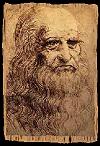|
Grotesque Faces When people think of Leonardo they tend to think of his angels, Madonnas and sweet ladies, but beside these can be found some surp6rising caricatures. In Milan, Leonardo would wander the streets drawing interesting people and faces. He was often to be located in the most wretched areas where he thought grotesque faces were best found.
His drawing of A Grotesque Head, done in 1504, is almost like-sized and has been pricked for transfer, but its purpose is unknown and there is no record of a commission for this work. This particular art form was popular in the 15th century and by at the end of the 16th century the grotesque had wide appeal among European artists. Leonardo also had a taste for pranks. One day, in Rome, he chose to entertain and terrify visitors by inflating the entrails of a large ram and allowing them to float through the door. Assembled guests flattened themselves against the walls in terror. Isabella d'Este The drawings done of Isabella d'Este were probably studies for a portrait she much desired Leonardo to do. It seems he lacked interest in the project, avoiding her when possible and never getting further than what you see here (refer thumbnails). Leonardo probably sketched her while he was in Mantua in 1500 and the artist obviously impressed his sitter greatly. She proceeded to spend the following four years inundating him with offers of commissions, begging or commanding he give her his attention as the mood took her. Isabella was highly insistent that he do a coloured portrait of her; this almost certainly never eventuated. Leonardo went as far as doing a cartoon of black chalk heightened with red for her hair and skin. Of particular interest is the fact that the dress is drawn in yellow pastel, making this the only pastel remaining by Leonardo. It shows her seated and wearing a wide-necked dress, her hands delicately folded and her head in profile. The cartoon is now widely accepted to be an original work, though there are a number of other copies in various places and some doubts have been expressed about the cartoon. Questions arose over this piece for several reasons. Firstly, it has been extensively reworked, a situation which always makes identification difficult. Secondly, as it has been pricked for transfer the correct outlines of the cartoon are obvious under close examination. This showed that the arm was drawn in a manner which is anatomically incorrect. With his exacting studies on the human body, including dissection, it is very unlikely Leonardo would make such a basic mistake. Portrait of a Warrior Though many thousands of drawings by Leonardo have survived the past 500 years, few have ever been considered finished 'showpieces'. Portrait of a Warrior, more correctly called The Condottiere, is one of these and comes from Leonardo's apprentice years. It was done in silver-point, a medium which involves the use of an extremely dainty touch. The year of this work has been much debated though somewhere around 1470-1480 would probably be accurate. Some experts have put forward the suggestion that this is a self-portrait, however no evidence for this exists. It is likely this was based on one of Verrocchio's bronzes, or his equestrian monument of Colleoni. Pageants Several drawings are also shown below which were costume studies done for pageants, fairs and masquerades. Youth with a Lance, Woman Wearing a Bodice of Interlaced Ribbons, Youth on Horseback, and Shackled Man were probably done after 1512 and intended for the Festival of Paradise. Throughout his life Leonardo did much work in this area, also designing and making masks. |
|

